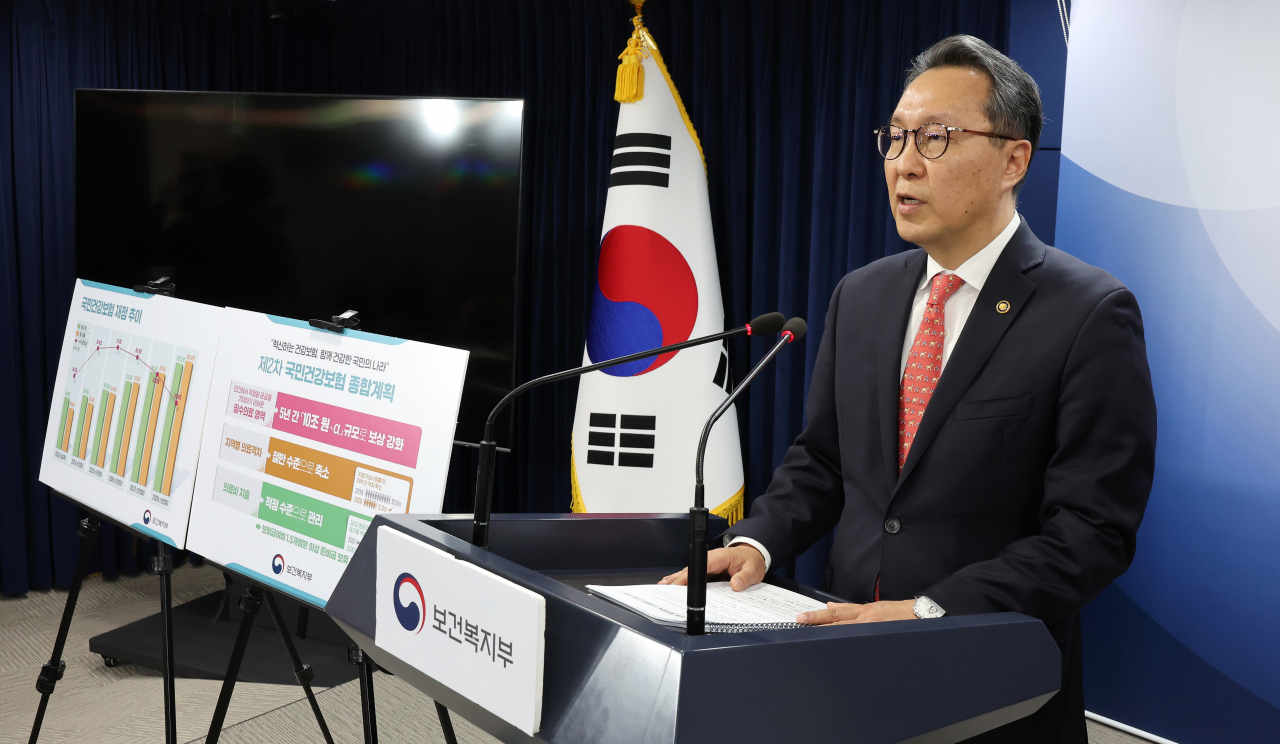Korea to push for ‘fundamental shifts’ in health insurance for sustainability
Placing ‘guaranteed medical service’ at its core, ministry to salvage shortage sectors such as maternity care, pediatrics
By Park Jun-heePublished : Feb. 4, 2024 - 15:18

South Korea’s Ministry of Health and Welfare on Sunday rolled out a five-year plan to push for “fundamental shifts” in the national health insurance system to ensure sustainability in the face of a health care supply crisis and rapid population downsizing.
The 2024-28 comprehensive plan aims at better compensating essential but undervalued medical services to tackle the shortage of medical professionals in certain sectors, as well as target the issues of overtreatment and overspending in the national health care system.
The ministry said there was an urgent need to reform the existing national health insurance system as it has further aggravated structural issues, including regional health care disparities, shortages in essential medical services, and unwarranted surges in national health care use.
“Our country boasts one of the best health insurance schemes among OECD nations. But the conditions are rapidly changing due to the collapse in essential medical services and the services in regional areas,” Second Vice Minister of Health and Welfare Park Min-soo said at a press briefing held at the Government Complex Seoul.
Park underscored that the ministry would “inject more than 10 trillion won ($7.47 billion) in concentrated support over five years into areas crucial to the life and health of the people but are not adequately supplied.”
The necessary medical fields that were incompatible with the fee-for-service system, or FFS, will benefit from the public policy fee scheme. Under the measure, the pediatrics, critical care, mental health and infectious diseases sectors will receive payments depending on the urgency of the procedures and the difficulties and risks of the services not reflected in the FFS system.
Currently, health care providers eligible for FFS are paid a fee by the National Health Insurance Service for each service rendered, but this often fails to align financial incentives with patient outcomes, the ministry explained.
Another initiative unveiled by the ministry to enhance essential services is the alternative payment model that gives added incentive payments to provide high-quality and cost-efficient care. It intends to remove pay disparities through several pilot projects.
For example, the ministry will trial a scheme to compensate each public specialized medical center for children for their operating losses until 2025. The compensation will be based on their success in meeting performance targets.
For the critical medical care sector, the ministry will reimburse institutions based on performance evaluations, which will look at their success in reducing the number of outpatient visits and improving the quality of treatment so that related institutions can prioritize quality over quantity in care provision.
To bridge the health equity gap between cities and non-metropolitan areas, the ministry plans to change the health care delivery system to provide necessary medical care when and where patients need it.
Under the plan, the ministry will designate each region’s national university hospitals as “responsible medical institutions” so that they can beef up cooperation between local medical institutes to remove the growing problem of shrinking access in underserved areas.
In addition, the ministry will expand the scope of out-of-pocket maximums, strengthen support for disaster-related medical expenses and improve the health care safety net for vulnerable populations. It added that it would continue alleviating the medication cost burden that cancer and rare diseases impose on patients and come up with measures to cut healthcare fees by expanding the integrated nursing and care service program.
However, to efficiently manage finances, the ministry will simultaneously take measures to prevent overtreatment and overspending in the national health insurance system.
To prevent unfavorable out-of-pocket choices for patients, the ministry will provide information on which medical treatments are not covered.
The ministry aims to implement a fair and equitable approach to incentivize responsible use of the national health insurance system. Notably, South Korea’s average annual outpatient visits per person stood at 15.7 in 2021, a figure three times higher than the OECD average of 5.9 visits.
In this initiative, individuals who have demonstrated a tendency to overuse the system will receive adjusted rates, while those who underutilize it will be eligible for reimbursements.
For example, individuals who have 365 outpatient visits a year will be required to cover 90 percent of the cost of treatment, as opposed to the usual 30-50 percent.
In cases of health insurance subscribers using few medical services, the ministry will pay 10 percent of the insurance premium paid in the previous year in vouchers, although it has yet to be decided when the scheme will be put into action.
The ministry said it would internally discuss the standard for the use of services and announce it at a later time.
The ministry will also launch a notification service that provides information on each individual’s health care use and medical expenditure spent every three months.



















![[Today’s K-pop] Treasure to publish magazine for debut anniversary](http://res.heraldm.com/phpwas/restmb_idxmake.php?idx=642&simg=/content/image/2024/07/26/20240726050551_0.jpg&u=)